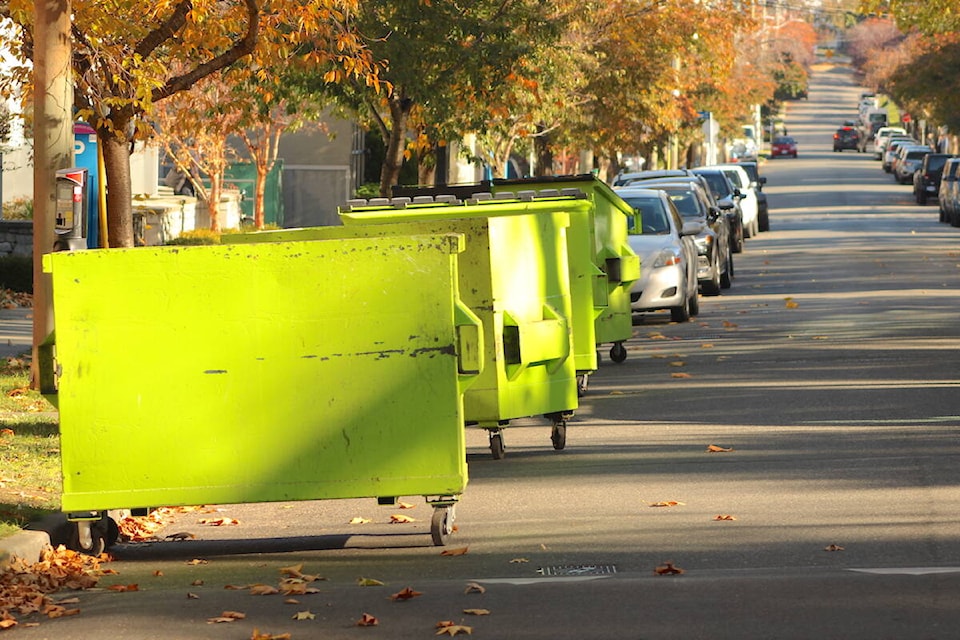While it hopes price signals make an immediate dent in the amount of organic waste being trashed, the Capital Regional District may look into mandating every community has kitchen and yard waste collected at the curb.
The per capita amount of organic waste going to the Hartland Landfill Facility has been falling since 2010, but CRD officials say the region has to divert the materials at a faster rate to meet waste-reduction targets.
The 2022 Waste Stream Composition Study found 17 per cent – or 28,500 tonnes – of organics were landfilled, making it the region’s second-largest type of waste.
The region’s main plan to divert compostable material away from the dump is incentivizing haulers to collect multiple kinds of waste. The waste movers will get a reduced tipping fee rate for the next two years if they offer services that ensure organics and recyclables aren’t being thrown in with garbage.
But at the Oct. 18 environmental services committee meeting, some CRD directors doubted that leaving organics diversion in the hands of private operators would be enough to meet waste reduction targets. The region is trying to reduce organic waste from 67 kilograms per capita in 2021 to 42 kg by 2031.
The committee ultimately voted to have staff evaluate and report on pathways to mandatory curbside organics collection in every CRD community.
The entire CRD still has to approve the direction.
The CRD has the legislative authority to create a bylaw that regulates mandatory collection, staff said.
Such a bylaw could involve municipalities providing collection directly, residents and businesses procuring private haulers or the CRD offering a collection service similar to its blue box program. Staff said it would have to consult with communities to gauge support for a mandate and their preferred service delivery method.
Seven of the CRD’s 13 municipalities don’t offer any curbside organics collection and the six communities that do only provide the service to single-family homes. That leaves property owners of multi-family buildings and businesses in every community to decide whether they’ll hire a private collector to haul away the organics. Organics also make up the largest component of the garbage coming from both single and multi-family homes, according to the 2022 waste composition study.
Businesses, institutions and industrial properties also throw out organics more than any other material.
Langford, Highlands, Central Saanich, Metchosin and Sooke don’t provide any form of collection or drop-off programs for kitchen and yard waste.
Over 23,000 tonnes of food or kitchen scraps were dumped in Hartland landfill last year, despite a 2015 ban on those products. Avoidable food waste made up one-tenth of all the waste created in the CRD last year.
The kitchen scraps that do get collected by municipal or private vehicles are dropped off at a transfer area at Hartland before they’re shipped off to out-of-region composting facilities.
The CRD in 2021 decided it still wasn’t economical to develop an in-region organics processing facility based on the amounts being collected.
A staff report noted the region would generate a larger organics feedstock if curbside services are expanded, so a mandatory program could change the business case for having an in-region processing site.
As directors pointed to how the Capital Region’s emissions are still rising, the CRD recognizes that trucking away organics creates air pollution and decomposing landfilled waste – especially organics – emits more potent methane.
“We can reduce our collective emissions by decreasing the amount of waste we produce, and managing Hartland landfill in a sustainable manner,” the CRD’s Solid Waste Management Plan states.
READ: Almost half of what ends up in Greater Victoria’s landfill could’ve been diverted: CRD
READ: Victoria non-profit promotes composting options for all
READ: Car travel and natural gas use stress targets as CRD emissions rise
